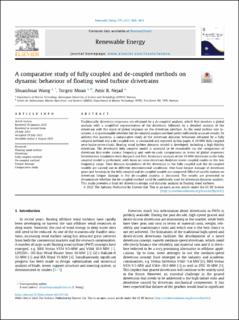| dc.contributor.author | Wang, Shuaishuai | |
| dc.contributor.author | Moan, Torgeir | |
| dc.contributor.author | Nejad, Amir R. | |
| dc.date.accessioned | 2022-07-05T07:17:41Z | |
| dc.date.available | 2022-07-05T07:17:41Z | |
| dc.date.created | 2021-08-19T14:47:06Z | |
| dc.date.issued | 2021 | |
| dc.identifier.citation | Renewable Energy. 2021, 179 1618-1635. | en_US |
| dc.identifier.issn | 0960-1481 | |
| dc.identifier.uri | https://hdl.handle.net/11250/3002660 | |
| dc.description.abstract | Traditionally, drivetrain responses are obtained by a de-coupled analysis, which first involves a global analysis with a simplified representation of the drivetrain, followed by a detailed analysis of the drivetrain with the input of global response on the drivetrain interface. As the wind turbine size increases, it is questionable whether this de-coupled analysis method yields sufficiently accurate results. To address this question, a comparative study of the drivetrain dynamic behaviour obtained by a fully coupled method and a de-coupled one, is conducted and reported in this paper. A 10-MW fully coupled aero-hydro-servo-elastic floating wind turbine dynamic model is developed, including a high-fidelity drivetrain. The developed fully coupled model is assessed to be reasonable via the comparison of drivetrain first-order natural frequency and code-to-code comparisons in terms of global responses between two simulation tools Simpack and Fast. Resonance analysis of the 10-MW drivetrain in the fully coupled model is performed, with focus on rotor-drivetrain-bedplate-tower coupled modes in the low frequency range. Time domain simulations of the drivetrain in the fully coupled and the de-coupled models are carried out in different environmental conditions. One-hour fatigue damage of drivetrain gears and bearings in the fully coupled and de-coupled models are compared. Effect of nacelle motion on drivetrain fatigue damage in the de-coupled analysis is discussed. The results are presented to demonstrate whether the de-coupled method could be confidently used for drivetrain dynamic analysis. This study provides a basis for drivetrain design and dynamic analysis in floating wind turbines. | en_US |
| dc.language.iso | eng | en_US |
| dc.publisher | Elsevier | en_US |
| dc.rights | Navngivelse 4.0 Internasjonal | * |
| dc.rights.uri | http://creativecommons.org/licenses/by/4.0/deed.no | * |
| dc.title | A comparative study of fully coupled and de-coupled methods on dynamic behaviour of floating wind turbine drivetrains | en_US |
| dc.type | Peer reviewed | en_US |
| dc.type | Journal article | en_US |
| dc.description.version | publishedVersion | en_US |
| dc.source.pagenumber | 1618-1635 | en_US |
| dc.source.volume | 179 | en_US |
| dc.source.journal | Renewable Energy | en_US |
| dc.identifier.doi | 10.1016/j.renene.2021.07.136 | |
| dc.identifier.cristin | 1927363 | |
| dc.relation.project | Norges forskningsråd: 223254 | en_US |
| cristin.ispublished | true | |
| cristin.fulltext | original | |
| cristin.qualitycode | 1 | |

